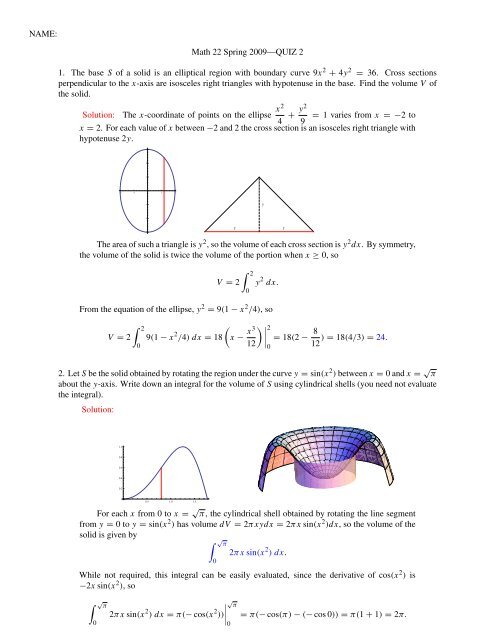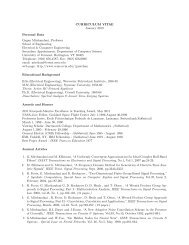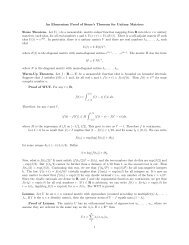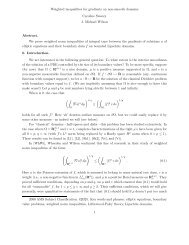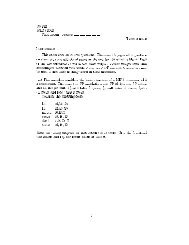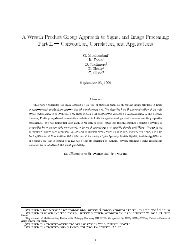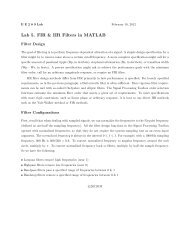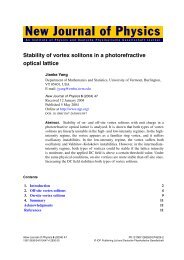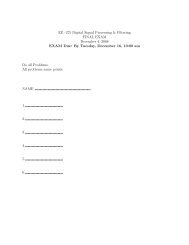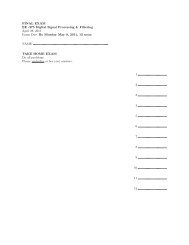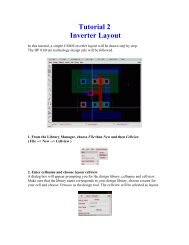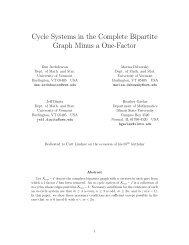NAME: Math 22 Spring 2009âQUIZ 2 1. The base S of a solid is an ...
NAME: Math 22 Spring 2009âQUIZ 2 1. The base S of a solid is an ...
NAME: Math 22 Spring 2009âQUIZ 2 1. The base S of a solid is an ...
You also want an ePaper? Increase the reach of your titles
YUMPU automatically turns print PDFs into web optimized ePapers that Google loves.
<strong>NAME</strong>:<br />
<strong>Math</strong> <strong>22</strong> <strong>Spring</strong> 2009—QUIZ 2<br />
<strong>1.</strong> <strong>The</strong> <strong>base</strong> S <strong>of</strong> a <strong>solid</strong> <strong>is</strong> <strong>an</strong> elliptical region with boundary curve 9x 2 + 4y 2 = 36. Cross sections<br />
perpendicular to the x-ax<strong>is</strong> are <strong>is</strong>osceles right tri<strong>an</strong>gles with hypotenuse in the <strong>base</strong>. Find the volume V <strong>of</strong><br />
the <strong>solid</strong>.<br />
Solution: <strong>The</strong> x-coordinate <strong>of</strong> points on the ellipse x2<br />
4 + y2<br />
= 1 varies from x =−2to<br />
9<br />
x = 2. For each value <strong>of</strong> x between −2 <strong>an</strong>d 2 the cross section <strong>is</strong> <strong>an</strong> <strong>is</strong>osceles right tri<strong>an</strong>gle with<br />
hypotenuse 2y.<br />
3<br />
2<br />
1<br />
2 1 1 2<br />
1<br />
y<br />
2<br />
3<br />
y<br />
y<br />
<strong>The</strong> area <strong>of</strong> such a tri<strong>an</strong>gle <strong>is</strong> y 2 , so the volume <strong>of</strong> each cross section <strong>is</strong> y 2 dx. By symmetry,<br />
the volume <strong>of</strong> the <strong>solid</strong> <strong>is</strong> twice the volume <strong>of</strong> the portion when x ≥ 0, so<br />
0<br />
V = 2<br />
∫ 2<br />
0<br />
y 2 dx.<br />
From the equation <strong>of</strong> the ellipse, y 2 = 9(1 − x 2 /4), so<br />
∫ 2<br />
) ∣<br />
V = 2 9(1 − x 2 /4)dx= 18<br />
(x − x3 ∣∣∣<br />
2<br />
= 18(2 − 8 ) = 18(4/3) = 24.<br />
12<br />
12<br />
0<br />
2. Let S be the <strong>solid</strong> obtained by rotating the region under the curve y = sin(x 2 ) between x = 0 <strong>an</strong>d x = √ π<br />
about the y-ax<strong>is</strong>. Write down <strong>an</strong> integral for the volume <strong>of</strong> S using cylindrical shells (you need not evaluate<br />
the integral).<br />
Solution:<br />
<strong>1.</strong>0<br />
0.8<br />
0.6<br />
0.4<br />
0.2<br />
0.5 <strong>1.</strong>0 <strong>1.</strong>5<br />
For each x from 0 to x = √ π, the cylindrical shell obtained by rotating the line segment<br />
from y = 0toy = sin(x 2 ) has volume dV = 2πxydx = 2πx sin(x 2 )dx, so the volume <strong>of</strong> the<br />
<strong>solid</strong> <strong>is</strong> given by<br />
0<br />
∫ √ π<br />
0<br />
2πx sin(x 2 )dx.<br />
While not required, th<strong>is</strong> integral c<strong>an</strong> be easily evaluated, since the derivative <strong>of</strong> cos(x 2 ) <strong>is</strong><br />
−2x sin(x 2 ),so<br />
∫ √ √<br />
π<br />
2πx sin(x 2 )dx= π(− cos(x 2 π<br />
))<br />
∣ = π(− cos(π) − (− cos 0)) = π(1 + 1) = 2π.<br />
0
2<br />
3. Find the average value <strong>of</strong> the function f(x)= 4x − x 2 on the interval [0, 4].<br />
Solution: <strong>The</strong> average value <strong>is</strong> given by<br />
1<br />
4<br />
∫ 4<br />
0<br />
(4x − x 2 )dx= 1 ) ∣ (2x 2 − x3 ∣∣∣<br />
4<br />
= 1 4 3 4 (32 − 64 3 ) = 8 3 .<br />
0


